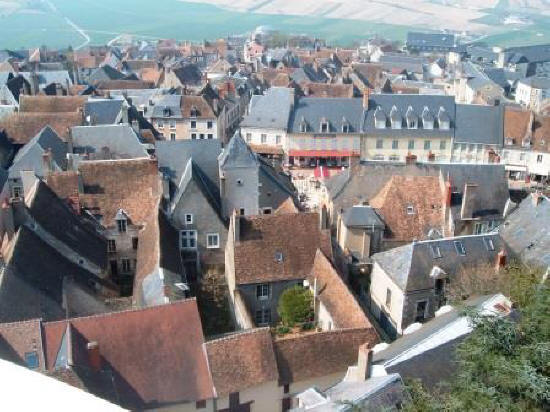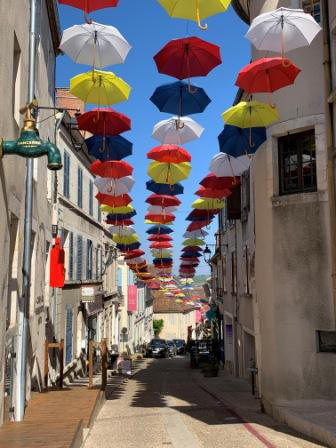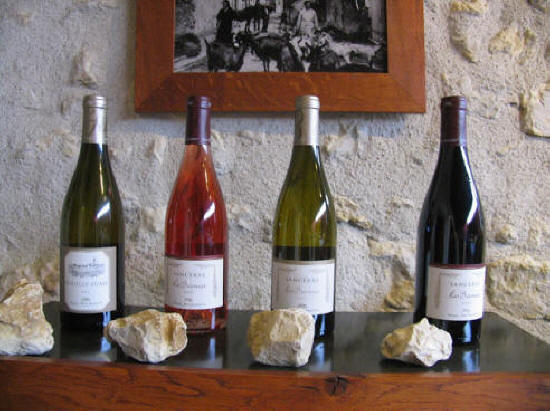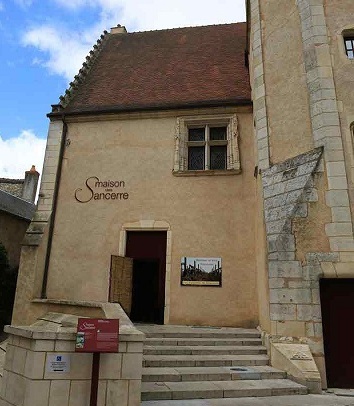What may surprise you most (it did us) on a visit to
the village of Sancerre, in the department of
Cher is the way that it rises from the plains of
the Loire Valley as if to proclaim its position as
lord of all it surveys. It is a position of strength
that has made the village a strategic location for
most of its history. The village grew up around a
small church and then abbey of the11th century but
there is evidence of an even earlier Roman
settlement - it was probably they who planted the
first vines.
This eventually led to a fortress being
built by local noblemen in the 12th century to
secure what at the time was one of the most
important defensive sites of the region. The castle
walls had six defensive towers built
into it - one, the
'Tour
des Fiefs' which has survived the
ravages of time, can still be climbed
today to take in the surrounding
panoramas. The fortification helped repel
English armies from two attacks during
the Hundred Years' War, unfortunately
the protection did not extend to the
nearby church and abbey which were
destroyed by the English.

During the French ‘Wars of Religion’ the
town was also the site of the
infamous ‘Siege of Sancerre’ (3
January-19 August 1573) where
the Huguenot (Protestant) population
held out for nearly eight months against
the Catholic forces of the king before
finally giving in to starvation - they
were reduced to eating their dogs - and
a promise of religious freedom that
never actually materialised. The king
would eventually order the destruction
of the defences so as to prevent any
future resistance to the crown. Speaking
of
resistance, the town also played its part during
WWll as the regional centre for the French
Resistance.

There is a pretty
town centre where the majority of commerce can be
found. There are a
number of good
restaurants
in and around
Sancerre including the
Michelin rated La Tour in the
town centre itself and with
choices from pizzas to gourmet
cooking you should be able to
find something to suit your
tastes and budget. There is also a
'salon de the' within the well
stocked patisserie.

Dressed for summer 2020
Despite its turbulent history the town has been able
to maintain much of its architectural heritage with
many fine examples of 15th century houses surviving
to this day. Its picturesque streets make exploring
the town a pleasure and you will find yourself
stopping off at a cafe or restaurant or trying the
famous local wine in the many wine caves spread
throughout the town.
Ah! the wine - it's what brings most visitors
here - it's why we went. The dry, white Sancerre
wines from the Sauvignon Blanc grape have made
this little corner of France famous the world
over but did you know that until the dreaded
phylloxera
arrived in the late 19th century, this was Pinot
Noir country producing mainly red wines. The
Sauvignon Blanc grape planted to replace the
lost vines thrives in the variety of soils (terroirs)
that surround the town. Limestone, clay and
flintstone (silex) all contribute to the tastes.
The area which includes many of the surrounding
hamlets does however not only produce its famous
white wines but it is also home to some very
good red wines crafted from the Pinot Noir grape
and some delightful, savoury rosé wines.

To get some insight
into the 'terroir'
and how it affects
the local wines we
suggest you visit
one of the caves where a very knowledgeable staff will
talk you through the
geological qualities
of the soil and
allow you to taste
their effect on the
wines.

Next to the church in the town, (3,Rue des Meridiens)
you will also find the
Maison-des-Sancerre
which provides the same comprehensive information on
the soil and the producers but in a more formal way
plus they will let you know about visiting the
hundreds of wine houses of the surrounding area. You
should also check out the views from their garden.